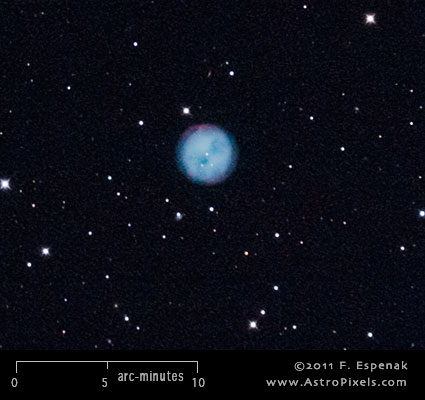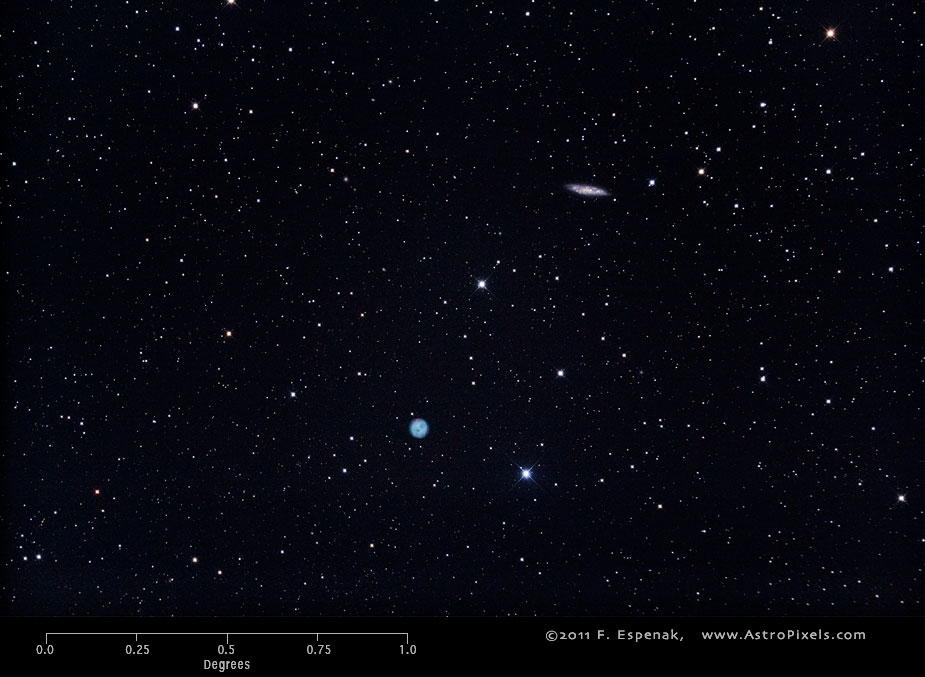
M97 - Owl Nebula
Messier 97 or M97 (also designated NGC 3587) is a planetary nebula in the constellation Ursa Major. It has an apparent visual magnitude of 9.9 and its angular diameter is 3.4x3.3 arc-minutes. M97 lies at an estimated distance of 2600 light years. The Equinox 2000 coordinates are RA= 11h 14.8m, Dec= +55° 01´ which makes M97 best seen during the spring. The Messier Spring Star Chart shows the position of all Messier objects visible during that season. As one of the more famous objects in the Messier Catalog, it is commonly known as the Owl Nebula.
The image above shows the uncropped view of planetary nebula M97 and galaxy M108 through the Takahashi E-180 Astrograph (North is up). A 3x enlargement of this image centered on M97 appears to the right.
M97 was discovered by P. Méchain in 1781. It is one of only four planetary nebulae in the Messier Catalog (M27, M57, M76, and M97). The name "Owl Nebula" is attributed to the 3rd Earl of Rosse who applied it M97 in 1848. According to Stoyan et al. (2010), the distance of this planetary nebula is 4140 light years and its diameter is 3.5 light years. Its estimated age is 6,000-12,000 years.
For more information, see the Messier Catalog as well as specific entries for M97 in Wikipedia and SEDS.
Messier's Description of M97
March 24, 1781
`Nebula in the great Bear [Ursa Major], near Beta: It is difficulat to see, reports M. Méchain, especially when one illuminates the micrometer wires: its light is faint, without a star. M. Méchain saw it the first time on Feb 16, 1781, and the position is that given by him. Near this nebula he has seen another one, [the position of] which has not yet been determined [M108], and also a third which is near Gamma of the Great Bear [M109 near Gamma Ursae Majoris].' (diam. 2')
The two nebulae mentioned here have been identified as M108 and M109 by Owen Gingerich in 1953.)
Technical Details
- Object: M97
- Other Names: NGC 3587, Owl Nebula
- Object Type: planetary nebula
- Object Data: Apparent Magnitude = 9.9, Angular Size = 3.4x3.3 arc-minutes
- Object Position (Equinox 2000): RA= 11h 14.8m, Dec= +55° 01´, Constellation = Ursa Major
- Date/Time: 2011 Mar 29 at 06:46 UTC
- Location: Bifrost Astronomical Observatory, Portal, AZ
- Mount: Astro-Physics 1200GTO
- Telescope: Takahashi Epsilon 180 Hyperbolic Astrograph
- Camera: Canon EOS 550D (Rebel T2i) (modified with a Baader UV/IR filter)
- Field of View: 1.70° x 2.56° at 1.7 arc-sec/pixel (web version: 10.0 arc-sec/pixel)
- Exposure: 4 x 300s, f/2.8, ISO 800
- File Name: M97M108-01w.jpg
- Processing (Adobe Camera Raw): Graduated Filter, Vignetting Correction, Noise Reduction, White Balance, Curves
- Processing (Photoshop CS5): Average Images, Curves, Noise Reduction
- Original Image Size: 3454 × 5179 pixels (17.9 MP); 11.5" x 17.3" @ 300 dpi
- Rights: Copyright 2011 by Fred Espenak. All Rights Reserved. See: Image Licensing.
